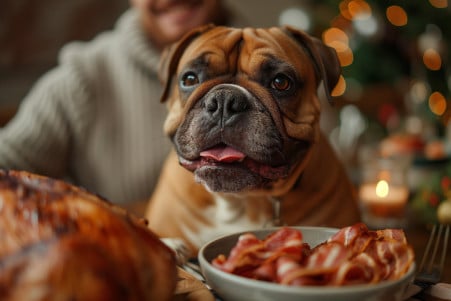Can Dogs Eat Raw Bacon? Uncovering the Risks and Safe Alternatives
4 February 2024

If you’ve ever wanted to spoil your dog with raw bacon but weren’t sure if it was safe, you’re not alone. While dogs can eat raw bacon, it’s not a good idea because the high fat and salt content can cause pancreatitis, and there is a risk of bacterial contamination, such as trichinosis. Instead, there are better, healthier, and safer options for your dog’s treats.
This article will use information from veterinarians and nutritional research to explain the ins and outs of dog diets, including what happens when dogs eat raw bacon. By the end of this article, you’ll know the potential health dangers and scientific reasons why raw bacon is not recommended for dogs, as well as nutritionally sound alternatives that will help you keep your dog healthy and satisfied.
Can dogs eat raw bacon?
The Impact of Bacon’s Fat and Sodium on Dogs
While dogs can’t resist the taste of bacon, the fat and sodium in the meat can have serious consequences. According to Pet Honesty, the fat in bacon can lead to pancreatitis in dogs, which is an extremely painful inflammation of the pancreas. This is especially common in smaller dogs, but it can happen to dogs of any size or age. Signs of pancreatitis include loss of appetite, vomiting, abdominal pain, and lethargy.
In addition to the fat, the salt in bacon can also cause problems. Pet Honesty warns that salt poisoning can occur in dogs who eat too much salt, and symptoms of this condition can include vomiting, diarrhea, tremors, seizures, and even coma. It’s important to make sure that dogs are eating a balanced diet, especially if they are eating foods that are high in salt and can lead to bloat, which can be fatal.
Many experts, including Dr. Rebecca MacMillan, agree that while a small piece of raw bacon may not cause immediate harm, dog owners should avoid giving it to their pets altogether. Instead, it’s best to stick to healthier, low-fat options to ensure your pet’s health and avoid these potentially life-threatening conditions.
Trichinosis: The Parasitic Threat in Raw Pork
Trichinosis, also known as pork roundworm, is a potentially life-threatening parasitic infection caused by the roundworm Trichinella spiralis. Dogs can get trichinosis from eating raw or undercooked pork that’s been infected with the parasite. After the dog ingests the infected meat, the parasite’s larvae are released in the dog’s intestines and then migrate to muscle tissue, causing inflammation and other issues that can have long-lasting effects.
Clinical signs of trichinosis in dogs, as listed by Wag Walking, include gastrointestinal symptoms, fever, stiffness, and muscle pain. In the most severe cases and if not treated, trichinosis can result in death.
The Merck Veterinary Manual explains that trichinosis is typically diagnosed in dogs based on a combination of a physical exam, a complete medical history, and diagnostic testing, such as fecal exams or blood tests.
While anthelmintic drugs can be used to treat trichinosis, the best way to manage the condition is to prevent it. This can be done by ensuring that all pork products are cooked to the proper internal temperatures—145°F (63°C) for roasts and 160°F (71°C) for ground meats—to kill any parasites that may be present.
To prevent dogs from getting trichinosis and to ensure that they stay healthy, dog owners should refrain from feeding them raw bacon.
Raw Dog Food: Are the Benefits Worth the Risks?
In their quest for a more “natural” way of feeding their pets, many dog owners have turned to raw dog food, which is made up of raw meat, bones, fruits, and vegetables.
Proponents of raw dog food, such as Australian veterinarian Ian Billinghurst, who promotes the “biologically appropriate raw food” (BARF) diet, claim that the diet leads to shinier coats, more energy, and cleaner teeth, all of which are consistent with the way dogs ate before they were domesticated. However, the FDA and many veterinarians are not convinced.
The potential benefits of a raw dog food diet are far outweighed by the potential risks. Although raw dog food advocates, including Dr. Doug Knueven, who wrote a book on the subject, claim that raw dog food is healthier than processed dog food, a study in BMC Veterinary Research found that raw dog food diets can expose dogs and their owners to dangerous bacteria like Salmonella and Listeria monocytogenes.
Raw dog food diets can also lead to nutritional deficiencies that cause problems like weak bones and anemia.
The FDA’s focus on the risks of bacterial contamination contradicts the claims of raw dog food proponents. Moreover, the scientific evidence against raw bacon in particular calls into question the wisdom of including it in raw dog food diets. As the research shows, the health risks of raw pet food diets, including raw bacon, are real and suggest that dog owners should look for safer, nutritionally complete alternatives for their pets.
Healthy Alternatives: Safe Snacks for Your Dog
Instead of raw bacon, opt for healthy, nutritious snack alternatives to keep your dog safe and happy. Raleigh Vet recommends fruits like apples, carrots, and blueberries, all of which are great options that provide vitamins and fiber and are low in calories. Similarly, Pets Domain ATX recommends carrots for their dental benefits and pumpkin for aiding digestionperfect for giving your furry friend a snack without the potential dangers of raw bacon.
You can also include cooked proteins like salmon, which Petco notes is high in omega-3 fatty acids, to give your dog a protein source that also supports their coat and immune system. When choosing snacks, follow the 10% rule to make sure that snacks make up no more than 10% of your dog’s daily caloric intake, which will help ensure they have a well-rounded diet.
When you’re introducing new snacks, start with small amounts and monitor your dog’s reaction, especially if they have a history of allergies or digestive issues. Always make sure to wash fruits and vegetables thoroughly and avoid foods that are toxic to dogs. By choosing these healthy alternatives, you’ll give your dog a tasty snack and help support their overall health.
How to Create a Healthy Diet for Your Dog
To promote the health and well-being of your pet, dogs require a diet that includes a variety of essential nutrients, including proteins, fats, carbohydrates, vitamins, and minerals, as well as plenty of water.
According to VCA Animal Hospitals, a healthy, balanced diet for dogs is essential for their overall health and well-being and will change depending on the dog’s age. A lack of these nutrients can lead to nutritional deficiencies that impact a dog’s growth, maintenance, energy requirements, and tissue repair.
Bacon treats, which are often high in fat and sodium, do not provide the balance of essential nutrients that dogs need. According to PetMD, dogs should not be fed a diet that consists of single ingredients, such as raw bacon, because it can lead to obesity and other health issues due to its high fat and salt content.
On the other hand, the ideal diet for dogs, as described by PetMD and the ASPCA, includes all the nutrients that raw bacon lacks. Owners should choose treats that are in line with their dog’s diet and meet the AAFCO’s standards for complete and balanced dog food.
When choosing treats, make sure that they don’t make up more than 10% of your dog’s daily caloric intake, and look for treats that are low in calories and fat, and free from potentially harmful ingredients—emphasizing nutrition over taste.
Conclusion
In summary, although it may be tempting to spoil our dogs with raw bacon, the potential risks associated with this treat make it a poor choice. The high fat and salt content in raw bacon can lead to pancreatitis and salt toxicity, both of which can cause life-threatening problems. In addition, feeding dogs raw bacon can lead to trichinosis, a parasitic infection that can have serious consequences for their health.
The benefits of choosing healthier treats are clear. Not only will these treats protect our pets from the risks of raw meat, but they will also provide nutrients that support their overall health. It’s important for responsible pet owners to take an active role in managing their dogs’ diets and to consult with veterinarians to get advice that’s based on the latest research.
In the end, our dogs’ health and well-being are the most important things. By choosing treats that are both safe and nutritious and ensuring that our pets are getting a well-balanced diet, we can make sure that our dogs have the best quality of life possible, free from the risks of raw bacon.


